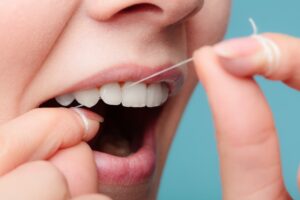Header logo
header top contact widget
Systemic Inflammation
Flossing – A Valuable Step In Avoiding Gum Disease & Tooth Loss
Posted on Mar 17, 2021 by William J. Claiborne, DDS MS
Adults who wish to stay healthy and active as they age often workout daily, walk at least 30 minutes per day, try to get 7 – 8 hours of sleep each night, and brush their teeth twice a day.
Tooth brushing helps to keep oral bacteria levels in the mouth to manageable levels. With the help of saliva, which is a rinsing agent for the mouth, these bacteria are generally kept under control. By preventing rampant growth, the ‘oral cavity’ (interior of the mouth) is able to avoid a destructive onslaught caused by these icky organisms.
A study shared by Dental Dental showed that about 70 percent of American adults brush their teeth twice a day. Unfortunately, this leaves more than a fourth of adults who do not.
Daily flossing is also recommended by the American Dental Association (ADA) as a preventative way to keep cavities and gum disease at bay. Still, an estimated 30 percent are committed to daily flossing – less than a third.
This means that a whopping 70 percent do not include flossing in their daily oral hygiene regimens. Too, about a third of Americans admit to never flossing, with 39 percent of men and 27 percent of women who do not.
Yet, the devotion of twice daily brushing and daily flossing requires only about 5 minutes of time – total. It is recommended to spend two minutes brushing teeth in the morning and before bed. A practiced flosser requires about a minute to floss. (Consider that five minutes is about the amount of time for a commercial break between TV programs.)
Yet, if you could see what I see…
As a periodontist, my specialty includes advanced training in the treatment of gum disease. I know the destructive nature of infectious oral bacteria. I have a bird’s eye view of what can occur without a committed oral hygiene routine at home. When an overload of bacteria accumulate in the mouth, cavities are able to form and gum tissues become food for living and breeding bacteria.
While brushing twice a day is important, the bristles of a toothbrush are typically unable to dislodge food particles caught between teeth. Left behind, these particles begin to rot rather quickly, leaving even more sustenance for bacterial growth and reproduction.
To see just how much your toothbrush misses, brush your teeth thoroughly for the recommended two minutes at the end of the day. Rinse and spit a couple of times. Then, using a strand of floss, move gently between teeth, easing up and down to reach the sides of all teeth. Move the floss just slightly beneath the gums at the base of each tooth. After all teeth are flossed, rinse and spit again. Most people are shocked at just how much their toothbrush failed to remove.
When oral bacteria amass past the point that is manageable by the immune system, these bacteria become infectious. This causes inflammation in the gum tissues, which can lead to the formation of periodontal (gum) disease. This begins with gingivitis, which has mild symptoms. Untreated, it worsens to periodontal disease and the advanced level of periodontitis.
It begins when oral bacteria accumulation creates a sticky film in the mouth known as plaque. When not removed thoroughly and frequently, plaque can form cement-hard bacteria colonies that attach to teeth. This hardened form of bacteria is known as tartar and, once formed, can no longer be brushed or flossed away.
As a Periodontist, I often see people who have developed periodontal disease who come (or have been referred) because they have obvious symptoms, such as red, swollen gums. However, I also see patients who are surprised to learn they have developed the disease. Yet, even without obvious symptoms, gum disease may exist and be fully underway.
Nearly half of American adults have some level of gum disease (over 47 percent in recent estimates). Periodontal (gum) disease is the nation’s leading cause of adult tooth loss even though it’s one of the most preventable of all diseases with simple measures.
Losing natural teeth leaves an individual with having to make decisions for replacement – crown-&-bridge combination, partial denture, full denture or Dental Implant. These time-consuming procedures and expenses can be avoided. And, contrary to what many believe, losing teeth is not a natural part of the aging process. With proper care, you can easily enjoy a smile of natural teeth all your life.
It is often surprising to people to learn that oral health is an integral part of overall health. Inflammation in the mouth doesn’t simply remain in the mouth. Through tears in diseased gum tissues, the oral bacteria of gum disease are able to enter the bloodstream. As the bacteria travel throughout the body, their toxic nature can activate inflammatory effects elsewhere.
Infectious gum disease bacteria have been the focus of a numerous amount of research over the years. Studies have found that the bacteria of gum disease can trigger or worsen heart disease, stroke, preterm babies, arthritis, diabetes, some cancers, Alzheimer’s disease, erectile dysfunction (ED) and impotency. As research continues, even more serious (and deadly) connections are being made.
They key is to keep oral bacteria levels to a minimum, which is why brushing and flossing are an important part of your daily care routine. Neither step should be taken for granted. Yet, as a periodontal specialist, I understand how it can be difficult to get into the habit of daily flossing.
For some, the tight floss around fingers is uncomfortable. For others who have large fingers or problems with manual dexterity, the act of flossing is awkward or challenging. However, for those who floss on a daily basis, it becomes a maneuver that is as simple as brushing teeth.
For individuals who are challenged by manual flossing, there are some excellent water flossers on the market. These are affordable and can be just as effective as ‘string’ flossing when used properly – and daily.
Twice daily brushing (at least two minutes per time), daily flossing, drinking ample water and limiting sweets and caffeine are simple ways to keep your mouth healthy between regular dental check-ups and cleanings. And, those 6-month check-ups are important. During these visits, tartar that may have formed can be removed and signs of early gum disease can be addressed.
If you are experiencing symptoms of gum disease, call 828-274-9440. In our state-of-the-art Asheville periodontal dental office, our patients are treated with respect, compassion and a gentle touch. Here, you’ll never be lectured. Our goal is to restore your smile to a healthy state and develop a program to help you keep it at its best.
New patients are always welcome. A referral is not needed to become a patient.
Smokers CAN Lower Oral Health Risks With Proper Measures
Posted on Feb 04, 2021 by William J. Claiborne, DDS MS
If you smoke, you may be tempted to quit as one of your New Year’s resolutions. By now, you may be “over the hump” and feel success in this challenge (and breathing much easier!). Good for you!
However, if you’ve stumbled and faltered (and perhaps even thrown up your hands in defeat), you are not alone. According to the Centers for Disease Control & Prevention (CDC), over 55 percent of smokers in the U.S. had made a quit attempt in 2018, with only 7.5 percent succeeding. (https://www.cdc.gov/tobacco/data_statistics/fact_sheets/cessation/smoking-cessation-fast-facts/index.html)
Yet, less than 7 percent of adult smokers reported (in 2015) that they had sought counseling or medications in their attempts to quit. Yet, the need for support is clear. For most people who are trying to quit, it is a long, tough journey. The CDC also reports that:
“more people in the United States are addicted to nicotine than to any other drug. Research suggests that nicotine may be as addictive as heroin, cocaine, or alcohol.”
As the need to maintain healthy immune systems has never been more urgent, smokers will hopefully reach out to every source in order to kick the habit, for good. Data assembled by a team at the University of California (San Francisco) found that smoking nearly doubles the rate of COVID progression.
The analysis took into account over 11,500 COVID patients. The findings showed by current and former smokers were twice as likely to have conditions that require hospitalization and higher death rates. (https://www.ucsf.edu/news/2020/05/417411/smoking-nearly-doubles-rate-covid-19-progression)
The authors of the study warned that both cigarettes and e-cigs were involved in this higher risk rate.
Smoking increases mucus production and inflammation, which injures the lungs’ defense system. This is why people who smoke are more likely to have serious respiratory infections and illnesses.
However, my role as an Asheville periodontist is not to lecture our patients. We believe our patients deserve to be informed about the risks to their oral health, in particular, and provide encouragement. Too, we want patients to understand the best ways to avoid developing periodontal (gum) disease and the subsequent repercussions (such as tooth loss) as a result.
So, let’s focus on your periodontal health if you smoke (including cigarette smoking or vaping).
Smokers are often unaware of what occurs in the mouth from smoking. To begin, smokers have a greater risk of periodontal (gum) disease due to its drying effect on the soft tissues in the mouth. When saliva flow is depleted, its ability to rinse away oral bacteria enables the mouth to a bacterial breeding ground.
As oral bacteria reproduce and accumulate in the mouth, gum tissues become inflamed. In the early stages of gum disease, symptoms may include frequent bad breath, tender and swollen gums, and gums that bleed easily when brushing teeth.
As gum disease progresses, the gums change in color from a healthy pink hue to red. The gums loosen their grip around the base of teeth and seem more spongy. Breath odor is consistently bad. Pus pockets may form at the base of some teeth.
Eventually, the bone and the tissue structures that support natural teeth are under attack. The infectious bacteria ramp up their onslaught of attack, tooth roots no longer have the firm support they need. Some teeth begin to loosen and may require removal.
Advanced periodontal disease, known as periodontitis, is a health risk that goes far beyond the mouth. For years, research has shown an intricate connection between the “good” bacteria in the mouth, especially beneficial in gut health. It has also been known that the “bad” and infectious bacteria of advanced gum disease can alter the roles of certain factors in the body that help to prevent the formation of disease.
For example, certain cancers can be activated or progressed through the inflammatory bacteria of gum disease. These bacteria are able to become blood borne and activate “pathogens” that create a domino effect of disease development.
When you factor in the vulnerability to the lungs from inhaling the toxic smoke of cigarettes, you have a perfect storm. Consider that the gum tissues are the first contact with these inhaled chemicals. Because oral tissues are absorbent in nature, they are at the front line of smoking’s effect.
If you do smoke, we want to help you minimize the risks it poses to your oral health. In addition to maintaining regular dental check-ups and cleanings (at least every 6 months), below are some tips for your at-home oral hygiene regimen.

• Brush twice a day (at least) for two minutes each time. Use a fluoridated toothpaste and a soft to medium bristle toothbrush.
• Floss your teeth every day and floss before your brush. You would be surprised at how many particles can be lodged between teeth that brushing won’t rid. If flossing is an awkward maneuver, try one of the water flossers, which are affordable and as effective as manual flossing.
• Brush your tongue after your teeth to unroot embedded bacteria, especially reaching the back area of the tongue (where most bacteria are embedded). This also helps to give you fresh breath.
• Use an oral rinse that replenishes moisture (and is alcohol-free) twice a day (or as directed). These are available OTC at most drug stores.
• Chew sugarless gum, preferably a brand that contains Xylitol. Xylitol looks and tastes like sugar, yet has 40 percent fewer calories.
• Drink plenty of water throughout the day. Be aware that beverages such as most coffee, tea and colas contain caffeine are drying to the mouth. Many medications also have the side effect of oral dryness – another good reason to stay hydrated.
• Limit your intake of sugar and carbohydrates. These are oral bacteria super boosters.
In our Asheville periodontal dental office, please know that we are here for you regardless of your needs or goals. Although we prefer you give up smoking, we want to give you the very best care possible so you can enjoy a healthy mouth and confident smile.
If you haven’t had regular dental exams or have any of the symptoms associated with gum disease (mentioned above), call our dental office to schedule a thorough periodontal exam at 828-274-9440.
Erectile Dysfunction (ED) Risks Increase With Presence of Gum Disease
Posted on Jan 07, 2021 by William J. Claiborne, DDS MS
Men have a long way to go when it comes to taking good care of their teeth and gums, according to several surveys.
One from the Academy of General Dentistry stated that men in the U.S. are less likely to have regular dental check-ups and cleanings than women. Another survey shared by the Journal of Periodontology said men are less likely to brush regularly, and more likely to lose teeth as they age as well as develop oral cancer and gum disease.
According to the Centers for Disease Control & Prevention, over 56 percent of men have gum disease, compared to just over 38 percent of women. Men, in particular, should be aware of the increased health risks associated with periodontal (gum) disease.
Researchers have given closer assessment to recent studies and found that erectile dysfunction (ED) is more common in men with gum disease.
In addition to higher ED risks, research has found that men with a history of gum disease are 14 percent more likely to develop cancer than men with healthy gums – 49 percent more likely to develop kidney cancer, 59 percent more likely to develop pancreatic cancer and 30 percent more likely to develop a blood cancer.
If concerns about heart disease and cancers aren’t enough to get men thinking more seriously about their oral health, ED may be a condition that does.
Gum disease has emerged as an independent risk factor for cardiovascular disease, and cardiovascular disease raises the risk for ED. For men, there are a number of factors that contribute to an increased risk of cardiovascular disease. These include smoking, obesity, chronic stress, high cholesterol, high blood pressure, and chronic sleep apnea.
One study published in the Journal of Sexual Medicine revealed that men in their thirties with severe gum disease are 3 times more likely to have erection problems. As cardiovascular health issues develop, erection ability suffers, and as health problems increase in number and severity, so does the severity of ED.
The association between periodontal disease, heart disease, and erectile dysfunction relates to inflammation brought on by gum disease bacteria. This process actually comes down to a biochemical reaction. During sexual arousal, the body releases nitric oxide, which plays a key role in enabling erection. Chronic inflammations, including periodontal disease, impairs release of nitric oxide and contributes to ED.
In the U.S., an estimated 18 percent of males have erectile dysfunction. Although men who are over age 70 are more likely to have ED, males most affected by ED are getting younger. One outpatient clinic showed that 1 in 4 men who sought help for erectile dysfunction were under the age of 40.
Could maintaining a healthy mouth lower the risk of ED? In a 2013 study, it was found that treating periodontal disease improves ED symptoms. Thus, a growing number of physicians are advising male patients who have both ED and periodontitis to seek periodontal treatment as a way to reduce its risk.
In data analyzed from five studies published between 2009 – 2014 (which included 213,000 male participants between ages 20 – 80), men who had chronic periodontitis (advanced gum disease) were more likely to have erectile dysfunction.
In another study, nearly half of the men with ED also had diabetes, another chronic inflammatory disease with links to periodontal disease. Chronic inflammation in the body can be lowered when gum health is kept in good condition.
Men can help to protect their overall health by keeping their oral health at an excellent level. It is especially important to watch for signs of gum disease. Symptoms include: puffy, red gums; inflamed, swollen, or bleeding gums; gums that recede from the base of teeth; and persistent bad breath.
If you are experiencing any of these symptoms, call our Asheville periodontal dental office for an examination as soon as possible. Gum disease does not improve without treatment.
Although many serious health problems are linked to the potent bacteria of gum disease, it is one of the most preventable of all diseases. Twice daily brushing, daily flossing, a diet limited in sugar and carbohydrates and drinking plenty of water are simple guidelines to follow.
Even with these easy steps that take mere minutes per day, it is estimated that over 47 percent of American adults have some level of gum disease.
For the good of your overall health and well-being, renew your commitment to a healthy smile for the new year. Begin with a thorough examination. (A referral is not required.) We’ll discuss how to get your oral health in good shape and ways to maintain it between dental check-ups.
Call 828-274-9440 to schedule or ask to begin with a consultation. If dental anxiety or fear has kept you from regular dental care, mention this during your appointment. This is a common problem for both men and women. If desired, we offer a number of comfort options, including Oral Sedation or I.V. Sedation (twilight sleep).
If Your Mouth Is Frequently Dry, You Have Higher Risk For Gum Disease
Posted on Dec 02, 2020 by William J. Claiborne, DDS MS
Our bodies are home to trillions of micro-organisms. This includes micro ‘ponds’ of viruses, fungi, and bacteria. As we’ve learned over the years, some of this bacteria is highly beneficial to how our systems operate.
Although the thoughts of bacteria often conjure up images of infectious organisms, the mouth is home to some very “good” bacteria. For bacteria that are present under normal circumstances, they do not cause disease and actually have a purpose. It’s the “bad” bacteria I want to focus on for now.
Oral bacteria is the source of nearly every problem that develops in the mouth. The oral cavity (mouth) is structured to manage a certain level of bacteria. As the entry point of most of the bacteria we add to our bodies, it can process a “normal” amount on a day-to-day basis. It is the overload of bacteria that becomes the origination source of problems.
The reason people are advised to brush at least twice a day and floss daily is to remove accumulated oral bacteria from the mouth. When not removed on a regular basis, a sticky film of bacteria form that coats the teeth and gums. This film is known as plaque. Without sufficient and frequent removal of plaque, it begins to harden at the base of teeth.
This is tartar (or calculus), which is actually a cement-hard mass of oral bacteria. Tartar cannot be brushed or flossed away; it requires removal by a dental professional. During your dental cleanings, you probably notice when your hygienist is scraping away at teeth. It is tartar that she is trying to remove.
Your periodic dental cleanings are important. If tartar is allowed to further amass, the bacteria can become inflamed, attacking gum tissues. As bacteria continue to reproduce, they create an inflammation that extends beneath the gum line. The infection they trigger can reach down into the structures that support natural teeth, including tooth roots, tissues, ligaments and bone.
Periodontal disease is the leading cause of adult tooth loss. The advanced stage of gum disease, known as periodontitis, creates a bacteria so potent that research has linked it to serious diseases elsewhere in the body. These include some cancers, heart disease, stroke, Alzheimer’s disease, diabetes, arthritis, preterm babies, and impotency.
Saliva is the mouth’s natural rinse that helps cleanse oral bacteria from the mouth. This keeps bacteria levels to a minimum and lowers their ability to cause problems. When saliva flow is depleted, however, bacteria remain in the mouth longer – and multiply rapidly.
Saliva helps to continually cleanse your mouth, removing particles that can rot and cause bad odors. A condition called “dry mouth” (known as Xerostomia) is when production of saliva is decreased.
When the “dry mouth” condition is continual, the problem may be due to low salivary gland production or some diseases. Dry mouth naturally occurs during sleep and in people who breathe through their mouth. However, as a periodontal specialist, I find that most cases are due to factors that can be easily controlled with simple changes.
To support saliva flow and reduce “bad” bacteria in the mouth, twice daily brushing and flossing help. However, knowing contributors to a dry mouth can help you better manage or control oral bacteria levels. These include:
The aging process – Aging causes the skin, cartilage, and tissues to become less supple, drier. We can’t stop the aging process but can help protect our oral health by drinking plenty of water throughout the day. Coffee, tea and colas don’t count. Also, consider using an oral rinse designed to replenish moisture in the mouth.
Medications – Many over-the-counter and prescribed medications today have a side effect of oral dryness. Some of the worst culprits are antihistamines, depression and incontinence medications, and some that control blood pressure. If you take one of these, ask your doctor about options that may be less drying to the mouth. Or, increase your water intake and use a daily rinse to replenish oral moisture.
Sleep habits – To dry something out, a flow of air is just the thing. This also applies to the mouth. Snoring or breathing through the mouth during sleep create added dryness to oral tissues. Talk to your doctor about ways to resolve these problems. It may be as easy as adjusting your sleeping position or adding a side pillow.
Medical conditions – Having acid reflux, sinus infections, diabetes and bronchitis can cause dry mouth. A bad cold can also force people to breathe more through their mouth. For these conditions, be especially committed to your oral hygiene routine at home (brushing and flossing) and up your water intake.
Caffeinated beverages – Caffeine has a drying effect on oral tissues and therefore depletes the helpful rinsing benefits of saliva. Most colas contain caffeine, which is drying to oral tissues. Add to that the high acidity level in colas (also harmful to tooth enamel). Also drying are coffee and tea. Like colas, these drinks contain acid added to caffeine. If you drink these beverages, be sure to rinse your mouth after or alternate with gulps of water.
Alcohol (including beer and wine) – Mixed drinks, wine and beer are all drying to oral tissues. Add the acidity and sugar levels that exist in wine or mixers and these drinks pack a double-whammy to oral tissues. Again, swish with water between drinks or have a glass of water nearby to dilute the impact of these.
Smoking (cigarettes, cigars, vaping) – People who have smoked for years often have dry skin that ages their appearance far beyond their actual years. The same is occurring inside the mouth. Cigarette and cigar smoke is laden with toxic chemicals, which is true for e-cigs as well. Just be aware at your added risk and the drying effects and take added measures to keep your mouth clean and moist.
If you have delayed or avoided dental care, call 828-274-9440 to request a consultation, or begin with a thorough examination in our Asheville periodontal office. We offer the latest techniques, technology, and skills while always making patient comfort a top priority.
Recent Posts
Categories
Archives
- September 2024
- August 2024
- July 2024
- June 2024
- May 2024
- April 2024
- March 2024
- February 2024
- January 2024
- December 2023
- November 2023
- October 2023
- September 2023
- August 2023
- July 2023
- June 2023
- May 2023
- April 2023
- March 2023
- February 2023
- January 2023
- December 2022
- November 2022
- October 2022
- September 2022
- August 2022
- July 2022
- June 2022
- May 2022
- April 2022
- March 2022
- February 2022
- January 2022
- December 2021
- November 2021
- October 2021
- September 2021
- August 2021
- July 2021
- June 2021
- May 2021
- April 2021
- March 2021
- February 2021
- January 2021
- December 2020
- November 2020
- October 2020
- September 2020
- August 2020
- July 2020
- June 2020
- May 2020
- April 2020
- March 2020
- February 2020
- January 2020
- December 2019
- November 2019
- October 2019
- September 2019
- August 2019
- July 2019
- June 2019
- May 2019
- April 2019
- March 2019
- February 2019
- January 2019
- December 2018
- November 2018
- October 2018
- September 2018
- August 2018
- July 2018
- June 2018
- May 2018
- April 2018
- March 2018
- February 2018
- January 2018
- December 2017
- November 2017
- October 2017
- September 2017
- August 2017
- July 2017
- June 2017
- May 2017
- April 2017
- March 2017
- February 2017
- January 2017
- December 2016
- November 2016
- October 2016
- September 2016
- August 2016
- July 2016
- June 2016
- May 2016
- April 2016
- March 2016
- February 2016
- January 2016
- December 2015
- November 2015
- October 2015
- September 2015
- August 2015
- July 2015
- June 2015
- May 2015
- April 2015
- March 2015
- February 2015
- January 2015
- December 2014
- November 2014
- October 2014
- September 2014
- August 2014
- July 2014
- June 2014
- May 2014
- April 2014
- March 2014
- February 2014
- January 2014
- December 2013
- November 2013
- October 2013
- September 2013
- August 2013
- July 2013
- June 2013
- May 2013
- April 2013
- March 2013
- February 2013
- January 2013
- December 2012
- November 2012
- October 2012
- September 2012
- August 2012
- July 2012
- June 2012


